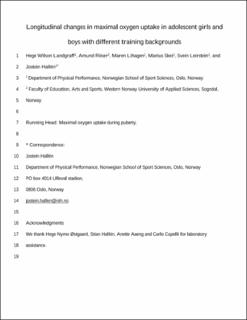| dc.contributor.author | Landgraff, Hege Elisabeth W. | |
| dc.contributor.author | Riiser, Amund | |
| dc.contributor.author | Lihagen, Maren | |
| dc.contributor.author | Skei, Marius | |
| dc.contributor.author | Leirstein, Svein | |
| dc.contributor.author | Hallén, Jostein | |
| dc.date.accessioned | 2022-04-07T10:58:10Z | |
| dc.date.available | 2022-04-07T10:58:10Z | |
| dc.date.created | 2021-05-11T11:12:22Z | |
| dc.date.issued | 2021 | |
| dc.identifier.citation | Scandinavian Journal of Medicine & Science in Sports. 2021, 31(S1), 65-72. | en_US |
| dc.identifier.issn | 0905-7188 | |
| dc.identifier.uri | https://hdl.handle.net/11250/2990487 | |
| dc.description | Dette er siste tekst-versjon av artikkelen, og den kan inneholde små forskjeller fra forlagets pdf-versjon. Forlagets pdf-versjon finner du på onlinelibrary.wiley.com / This is the final text version of the article, and it may contain minor differences from the journal's pdf version. The original publication is available at onlinelibrary.wiley.com | en_US |
| dc.description.abstract | The purpose of this study was to investigate the effects of high-volume endurance training on the development of maximal oxygen uptake (VO2max) in physically active boys and girls between the ages of 12 and 15 years, using a longitudinal design. The children participated in organized training in sports clubs for an average of 7-10 hours per week, with one group undertaking a high volume of endurance training (~7 hours per week; End boys, n = 23 and End girls, n = 17) and the other group having a primary focus on technical and tactical skill development, undertaking low volumes of endurance training (~1.6 hours per week; non-End boys, n = 29 and non-End girls, n = 9). VO2max and anthropometrics were assessed at age 12, 13, and 15. At age 12, VO2max was 58.9 (5.6), 65.5 (7.2), 56.5 (6.5), and 58.8 (7.9) mL·kg−1·min−1 in End girls, End boys, non-End girls, and non-End boys, respectively. Over the three years, there was no difference between the training groups in the development of VO2max independent of scaling. In boys, VO2max relative to body mass (BM) did not change from age 12 to 15, while VO2max tended to decrease relative to fat-free mass (FFM). In girls, VO2max relative to BM decreased slightly from age 12 to 15, with no changes over the years relative to FFM. The present longitudinal study suggests that in growing active children during puberty, high volumes of systematic endurance training do not have an additional effect on VO2max compared with similar volume of training mainly aiming at developing motor skills. | en_US |
| dc.language.iso | eng | en_US |
| dc.subject | adolescence | en_US |
| dc.subject | aerobic power | en_US |
| dc.subject | growth | en_US |
| dc.subject | maturation | en_US |
| dc.subject | puberty | en_US |
| dc.subject | VO2max | en_US |
| dc.title | Longitudinal changes in maximal oxygen uptake in adolescent girls and boys with different training backgrounds | en_US |
| dc.title.alternative | Longitudinal changes in maximal oxygen uptake in adolescent girls and boys with different training backgrounds | en_US |
| dc.type | Peer reviewed | en_US |
| dc.type | Journal article | en_US |
| dc.description.version | acceptedVersion | en_US |
| dc.source.pagenumber | 65-72 | en_US |
| dc.source.volume | 31 | en_US |
| dc.source.journal | Scandinavian Journal of Medicine & Science in Sports | en_US |
| dc.source.issue | S1 | en_US |
| dc.identifier.doi | 10.1111/sms.13765 | |
| dc.identifier.cristin | 1909389 | |
| dc.description.localcode | Institutt for fysisk prestasjonsevne / Department of Physical Performance | en_US |
| cristin.ispublished | true | |
| cristin.fulltext | postprint | |
| cristin.fulltext | postprint | |
| cristin.qualitycode | 2 | |
